Publikationen
1. Meert Guido F.: Das Becken aus osteopathischer Sicht. 2017 (4. Auflage) – Elsevier, München.
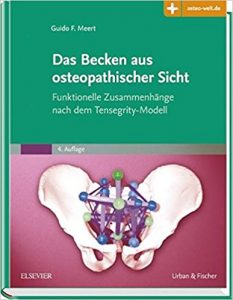
Das Standardwerk in 4. Auflage: Alles Wissenswerte über das Becken aus osteopathischer Sicht:
-
– verständliche Vermittlung physiologischer und pathologischer Zusammenhänge zwischen den parietalen Strukturen (Knochen und Muskeln des Beckens) und den Beckenorganen (Harnblase, Prostata, Uterus, Eierstöcke und Eileiter). Der Autor geht auf das Wechselspiel zwischen inneren Organen, ihrer bindegewebigen Umgebung und dem muskulo-skelettalen System bei der Krankheitsentstehung und der Therapie ein.
-
– Zusammenstellung unterschiedlicher Behandlungsverfahren (parietal/viszeral) für die einzelnen Beschwerdebilder
-
– Verknüpfung von gängigen Strategien mit vom Autor weiterentwickelten, bewährten Vorgehensweisen
-
– Zusammenstellung bewährter Diagnostik- und Behandlungsmethoden für die einzelnen Beschwerdebilder – Handgriff für Handgriff anhand von Fotos demonstriert
-
– auf die Bedürfnisse von Lernenden abgestimmtes Lehr- und Arbeitsbuch
Rezensionen:
-
– „Konkurrenzloses Lehr- und Praxishandbuch zu einem der zentralen Themen in der Osteopathie.“( Pharma Marketing Journal)– „(..) vor allem die hervorragende Verknüpfung von Biomechanik und Anatomie begeistert. Das Werk trägt aktuelle Theorien und Therapieprinzipien zusammen und regt zum Weiterdenken an.“ (physiopraxis)
-
– „(..) eine anregende Quelle der Information.“ (Die Säule)
-
– „(..) sowohl für ausgebildete Osteopathen als auch für Lernende empfehlenswert.“ (Therapie + Praxis)
-
– „Das Buch ist gut, sehr gut geschrieben. (…) Das Buch möchte man am liebsten nicht mehr weglegen, man möchte nach entsprechender Anamnese „ausprobieren“ und den Erfolg der Behandlung wahrnehmen. Ein Buch, das auf seine Art und Weise mehr als nur ein Lehr-/Lernbuch ist.“ (www.fsmed-dresden.de, Fachschaft Medizin der Universität Dresden)
2. Meert Guido F.: Das venöse und lymphatische System aus osteopathischer Sicht. 2014 (2. Auflage) – Elsevier, München.
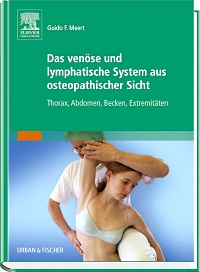
Die venösen und lymphatischen Körperflüssigkeiten spielen in der osteopathischen Diagnostik und Therapie eine zentrale Rolle.
Was bringt es, Patienten die besten Medikamente oder die besten Vitamine zu verabreichen, wenn diese am kranken Gewebe vorbei geschwemmt werden oder vorher stecken bleiben? Beispielsweise weil das Bindegewebe verspannt oder verklebt ist und die Medikamente, Vitamine und Nährstoffe demzufolge nicht in ihr Zielgewebe gelangen können? (Aus Meert Guido F.: Das venöse und lymphatische System aus osteopathischer Sicht. 2007 – Elsevier, München)
Allein schon aus dieser Sicht erscheint es notwendig, sich mit den Körperflüssigkeiten und myofaszialen Verspannungen zu beschäftigen. Der Autor hat verschiedene Lösungstechniken für Verspannungen und Pumptechniken für Stauungen entwickelt.
Neben den Grundlagen, vermittelt Ihnen das Werk leicht nachvollziehbar und praxisorientiert die Untersuchungs- und Behandlungstechniken in Wort und Bild.
- – Diese 564 Seiten sind wirklich jeden Cent wert für Therapeuten, die einerseits anatomisch und wissenschaftlich interessiert sind, aber andererseits sich nicht von reduktionistischen Modellvorstellungen abhängig machen wollen. pt – Zeitschrift für Physiotherapeuten, 04/2008, S. 484 ff.
- – Insgesamt liegt hier ein sehr praktisches Lehrbuch vor, dass für alle diejenigen, die es besitzen, sowohl Therapeuten als auch Studenten, von Nutzen sein wird. Osteopathische Medizin, 3/2007
- – Mit diesem Lehrbuch legt der schon längst bekannte Dozent und Autor für die Osteopathie ein glänzendes Grundlagenlehrbuch vor, in dem neben dem Basiswissen praxisorientiert die Untersuchungs- und Behandlungstechniken in Wort und Bild vermittelt werden. Dabei wird deutlich, dass hier nicht nur ein erfahrener Lehrer, sondern auch ein exzellenter Praktiker der Osteopathie weiterdenkt als üblich.(…) Autor und Verlag haben Wert auf höchste Druck- und Darstellungsqualität gelegt, ebenso auf didaktische und pädagogische Spitzenklasse, einzigartigen systematischen Aufbau sowie großzügige Präsentation auch des Details. Dem Buch ist eine große Verbreitung zu wünschen. Physikalische Therapie, 3/2007
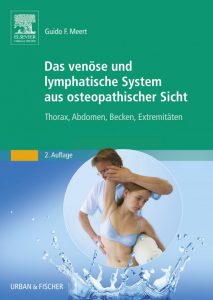 Neu in der 2. Auflage:
Neu in der 2. Auflage:
komplett überarbeitet und aktualisiert. Aktualisierung des Thema Bindegewebe und ein neues Kapitel über die
Behandlung des thorakalen Bindegwebes. Zusätzliche Abschnitte zu den Themen Ernährung und Eigeninitiative
sowie zum Säure-Basen-Haushalt.
3. Meert Guido F.: Veno-lymphatische kraniosakrale Osteopathie. 2012 – Elsevier, München.
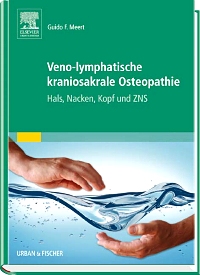 Prof. Neuhuber W. der Uni Erlangen bezeichnet das neue Buch von Guido F. Meert als „mutiges“ Buch und Dr. biol. Schleip R. betont die revolutionäre und „beseelte“ Sichtwiese des Buches. Der Autor selbst betrachtet das Buch als Möglichkeit, den eigenen „mechanistischen Wurzeln“ zu entwachsen und als Ansatz zum „vernetzten Denken“.
Prof. Neuhuber W. der Uni Erlangen bezeichnet das neue Buch von Guido F. Meert als „mutiges“ Buch und Dr. biol. Schleip R. betont die revolutionäre und „beseelte“ Sichtwiese des Buches. Der Autor selbst betrachtet das Buch als Möglichkeit, den eigenen „mechanistischen Wurzeln“ zu entwachsen und als Ansatz zum „vernetzten Denken“.
Die kraniosakrale Osteopathie ist einer der faszinierendsten Zweige der bunten osteopathischen Medizin. Um die Entwicklung der Osteopathie „begreifen“ zu können, ist es sinnvoll, zuerst nicht nur etwas über das spannende Leben von A. T. Still, W. G. Sutherland und M. J. Littlejohn, sondern auch über das Schaffen von F. J. Gall, E. Swedenborg und sogar J. W. Goethe und vielen Anderen zu erfahren. Da wo Rationalismus und Empirismus sich duellieren, da wo Materialismus und Vitalismus sich treffen, da wo Körper, Geist und Seele sich vereinigen treffen sich Leser und Autor…
Lymphgefäße sind so fein, dass bereits geringste Spannungsveränderungen zu Abflussstörungen und minimale Abflussstörungen wiederum zu Spannungsveränderungen führen können. Das Buch widmet sich den venösen, lymphatischen und zerebrospinalen Flüssigkeiten im Bereich von Kopf, Hals und zentralem Nervensystem und zeigt, wie man dort lokalisierte Störungen osteopathisch behandeln kann.
Der Autor geht weiterhin kritisch mit dem Gedankengut der Osteopathie um, aber scheut es auch nicht anzumerken, dass eine evidenzbasierte Medizin zweifelsohne eine wichtige Grundlage sein soll. Nur… EBM alleine reicht nicht aus und die Relevanz von randomisierten klinischen Studien hat durchaus ihre Grenzen. Im Rahmen der praktischen Tätigkeit eines Osteopathen in seiner Praxis ist beispielsweise eine Randomisierung und Standardisierung nicht immer umsetzbar. Die Osteopathie verfügt weiterhin momentan leider weder über die finanziellen Mittel, noch über eine Anbindung an medizinisch-wissenschaftliche Laboratorien und ist demzufolge, wie viele „Hands-on-Therapien“ von der EBM „wegrationalisiert“. Gibt es im „Big Science“ überhaupt einen Platz für osteopathische „Handarbeiter“, geschweige denn Forschungsgelder um die Effektivität der manuell-einfühlsamen osteopathischen Techniken zu erforschen?
Aus dieser Sicht erscheint es dem Autor und dem Deutschen Fortbildungsinstitut für Osteopathie – DFO umso wichtiger die Grundlagenforschung und eine „Individuum-basierte Osteopathie“ voranzutreiben. Dazu werden integrative Behandlungsmodelle vorgetragen, die in der Praxis individuell ausgearbeitet werden sollen. Es ist nun unbedingt eine Aufgabe für Universitäten und Fachhochschulen den „Denkrahmen“ etwas aufzulockern und einzuräumen, dass verschiedene „Wahrheiten“ sich gegenseitig ergänzen können. Dieses Buch kann man als „Denkanstoß“ dazu betrachten.
Es wäre unendlich schade, wenn man die kraniosakrale Osteopathie auf Grund der schlechten Reproduzierbarkeit des ominösen Kraniosakralrhythmus denunzieren würde. Dafür gibt es unzählige wichtige Themen der kraniosakralen Osteopathie, die ernsthaft diskutiert werden sollen. Dabei hat der Autor beispielsweise die Viskoelastizität der Schädelstrukturen, die Spannung der subokzipitalen myofaszialen Strukturen, die Funktionalität der Schädelnähte aus einem neuen Standpunkt, der Hämodynamik im Schädelbereich, die Spannungsmuster im Schädelbereich und etliche weitere Themen intensiv erforscht und ausgearbeitet. Mit neuen innovativen Behandlungstechniken wird Grundlagenforschung betrieben und interessante Hypothesen werden aufgestellt, die durch die experimentelle Wissenschaft ergänzt und verbessert werden sollen. Es wäre fantastisch, wenn sich im „Big Science“ Forschungsgelder für die Entwicklung dieser manuellen Behandlungsformen mobilisieren würden…
4. Meert Guido F.: Venolymphatic Drainage. An Osteopathic and Manual Therapy Approach. 2012 – Churchill Livingstone, Elsevier, Edinburgh.
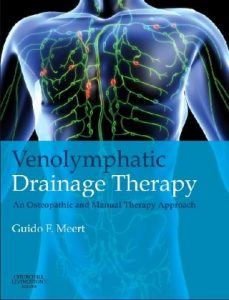 Prepared in an easy-to-follow, practical format, Venolymphatic Drainage Therapy: an Osteopathic and Manual Therapy Approach explores the anatomy, physiology, embryology and biomechanics of the venolymphatic system and also presents a variety of effective treatment options which range from the treatment of functional disorders of the diaphragm, the intraosseous fluid system, the spleen, liver and gallbladder, kidneys and ureters to the management of problems connected with the abdominal mesenteries and abdominal organs.
Prepared in an easy-to-follow, practical format, Venolymphatic Drainage Therapy: an Osteopathic and Manual Therapy Approach explores the anatomy, physiology, embryology and biomechanics of the venolymphatic system and also presents a variety of effective treatment options which range from the treatment of functional disorders of the diaphragm, the intraosseous fluid system, the spleen, liver and gallbladder, kidneys and ureters to the management of problems connected with the abdominal mesenteries and abdominal organs.
Richly illustrated with an abundance of artworks and photographs throughout, this volume will be ideal for osteopaths, chiropractors, physical therapists, physiotherapists and massage therapists worldwide.
5. Fascia: The tensional network of the human body. 2012 – Schleip R., Findley T. W., Chaitow L., Huijing P. A.. Churchill Livingstone, Elsevier, Edinburgh.
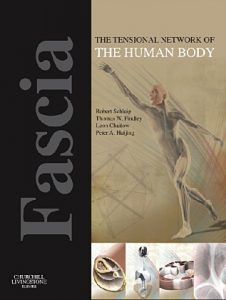 Guido F. Meert steuerte zu diesem Buch das Kap. 4.5 „Fluid dynamics in fascial tissues“ bei.
Guido F. Meert steuerte zu diesem Buch das Kap. 4.5 „Fluid dynamics in fascial tissues“ bei.
Kurzbeschreibung des Buches:
This book is the product of an important collaboration between clinicians of the manual therapies and scientists in several disciplines that grew out of the three recent International Fascia Research Congresses (Boston, Amsterdam, and Vancouver). The book editors, Thomas Findley MD PhD, Robert Schleip PhD, Peter Huijing PhD and Leon Chaitow DO, were major organizers of these congresses and used their extensive experience to select chapters and contributors for this book. This volume therefore brings together contributors from diverse backgrounds who share the desire to bridge the gap between theory and practice in our current knowledge of the fascia and goes beyond the 2007, 2009 and 2012 congresses to define the state-of-the-art, from both the clinical and scientific perspective. Prepared by over 100 specialists and researchers from throughout the world, „Fascia: The Tensional Network of the Human Body“ will be ideal for all professionals who have an interest in fascia and human movement – physiotherapists, osteopathic physicians, osteopaths, chiropractors, structural integration practitioners, manual therapists, massage therapists, acupuncturists, yoga or Pilates instructors, exercise scientists and personal trainers – as well as physicians involved with musculoskeletal medicine, pain management and rehabilitation, and basic scientists working in the field.
6. Venolymphatic Drainage Therapy – Guido F. Meert
Terra Rosa e-Magazine (June 2013) in Australien – www.terrarosa.com.au
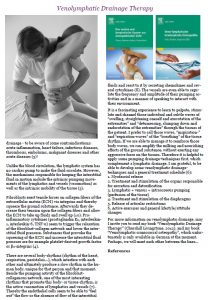
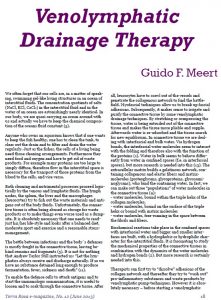
We often forget that our cells are, in a matter of speaking, swimming gel-like living structures in an ocean of interstitial fluids. The concentration quotients of salts (NaCl, KCl, CaCl2) in the interstitial fluid and in the water of an ocean are astonishingly nearly identical. In our body, we are quasi carrying an ocean around with us and actually we have to keep the chemical composition of the oceans fluid constant (5).
Anyone who owns an aquarium knows that if one wants to keep the fish healthy, one has to clean the tank, to clear out the drain and to filter and drain the water regularly. Just as the fishes, the cells of a living being need those cleaning arrangements. Furthermore they need food and oxygen and have to get rid of waste products. For example many proteins are too large to simply diffuse, therefore flow in the interstitial space is necessary for the transport of those proteins from the blood to the cells, and vice versa.
Both cleaning and nutrimental processes proceed logistically by the venous and lymphatic fluids. The lymph nodes, the spleen, the liver and the macrophages (leucocytes) try to fish out the waste materials and antigens out of the body fluids. Unfortunately, the connective tissue is often being abused as storage for waste products or to make things even worse used as a dumpsite. It is absolutely necessary that one needs to readjust his/her life-style and looks after a balanced diet, moderate sport and exercise and a reasonable stress-management.
The battle between infections and the body´s defenses is mostly fought in the connective tissue, leaving behind remains and fragments (5). It is not for nothing that Andrew Taylor Still instructed us: “Let the lymphatics always receive and discharge naturally. If so we have no substance detained long enough to produce fermentation, fever, sickness and death” (11).
To enable the defence cells to attack antigens and to start the immunologic communication, it is useful to loosen and to soak through the connective tissue. After all, leucocytes have to crawl out of the vessels and penetrate the collagenous network to find the battlefield. Myofascial techniques allow us to break up fascial adhesions. Subsequently, it makes sense to irrigate and purify the connective tissue by some venolymphatic drainage techniques. By stretching or compressing the tissue, water is being extruded out of the connective tissue and makes the tissue more pliable and supple. Afterwards water is readsorbed and the tissue search for new equilibrium. In connective tissue we are dealing with interfascial and bulk water. Via hydrogen bonds, the interfascial water molecules seem to interact with the folding and therefore also with the function of the proteins (1). Water in bulk seems to behave differently from water in confined spaces (f.e. in interfascial spaces), but more research is needed into this (13). The extracellular matrix builds a gelatinous network, containing collagenous and elastic fibers and matrix-molecules (proteoglycans, glycoproteins, glycosami-noglycans), who bind the containing water. In fact, we can make out three “populations” of water molecules in the connective tissue (9):
– water molecules, bound within the triple helix of the collagen molecules,
– water molecules, bound on the surface of the triple helix or bound with matrix molecules
– water molecules, free-running in the space between the fibrils and fibers.
Biochemical reactions take place in the confined spaces with interfascial water and bigger and smaller interfaces are built, with a hydrophobic or hydrophilic character for the interstitial fluids. It is fascinating to study the mechanical properties of the connective tissues in combination with the dynamics of the water molecules and hydrogen bonds (2). But more research is certainly needed into this.
Therapists can first try to “dissolve” adhesions of the collagen network and thereafter they try to “wash out” pro-inflammatory substances and waste products by venolymphatic pump-techniques. However it is absolutely necessary – before starting a venolymphatic drainage – to be aware of some contraindications: acute inflammation, heart failure, infectious diseases, thrombosis, embolisms, malignant diseases and other acute diseases (5)!
Unlike the blood circulation, the lymphatic system has no cardiac pump to make the fluid circulate. However, the mechanisms responsible for keeping the interstitial fluid in motion include the intrinsic pumping movements of the lymphatics and vessels (vasomotion) as well as the intrinsic mobility of the tissue (3).
Fibroblasts exert tensile forces on collagen fibers of the extracellular matrix (ECM) via integrins and thereby squeeze the ground substance. Afterwards they decrease their tension upon the collagen fibers and allow the ECM to take up fluids and swell up (10). Pro-inflammatory cytokines (prostaglandin E1, interleukin-1, interleukin-6, TNF-α) seem to trigger the relaxation of the fibroblast-collagen network and lower the interstitial fluid pressure. Substances that provoke the squeezing of the ECM and increase the interstitial fluid pressure are for example platelet-derived growth factor or β1-integrins (4).
There are several body-rhythms (rhythm of the heart, respiration, peristalsis…), which interfere with each other and ultimately produce a slow rhythm in the human body, unique for that person and that moment. Beside the pumping activity of the fibroblast-collagenous network, one of the most interesting rhythms that promote this body- or tissue-rhythm, is the active vasomotion of lymphatics and vessels (7). Thereby the endothelial cells seem to be able to “feel out” the flow or the absence of flow of the interstitial fluids and react to it by secreting chemokines and sev-eral cytoykines (8). The vessels are even able to regulate the frequency and amplitude of their pumping activities and in a manner of speaking to interact with their environment.
It is a fascinating experience to learn to palpate, stimulate and channel those individual and subtle waves of “swelling, straightening oneself and exorotation of the extremities” and “detumescing, slumping down and endorotation of the extremities” through the tissues of the patient. I prefer to call those waves, “inspiration-” and “expiration-waves” of the “breathing” of the tissue rhythm. If we are able to manage it to reinforce those body waves, we can amplify the milking and nourishing effects of the ground substance, without exerting any aggressive force on the tissues. Therefore it is helpful to apply some pumping drainage-techniques first, which complement a lymphatic drainage. I am grateful, to be able to develop some venolymphatic drainage-techniques and a general treatment schedule (6):
- Myofascial release
- Treatment and stimulation of the organs responsible for excretion and detoxification
- Lymphatic + venous + intraosseous pumping (perfusion of the tissue)
- Treatment and stimulation of the diaphragms
- Release of articular restrictions
- Active exercises and general lifestyle/attitude changes
For more information on venolymphatic drainage, may I invite you to read my book “Venolymphatic Drainage Therapy” (Churchill Livingstone, 2012), and my book “Venolymphatic craniosacral osteopathy”, which unfortunately is only available in German at the moment. Perhaps, we will meet each other between the lines…
References (auf Anfrage)
7. Six Questions to Guido Meert
e-Magazine von Terra Rosa in Australien, June 2013 – www.terrarosa.com.au
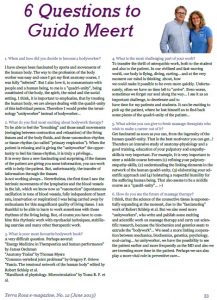
1. When and how did you decide to become a bodyworker?
I have always been fascinated by sports and movements of the human body. The way to the profession of the body worker was easy and once I got my first anatomy course, I was fully „infected“. But I also love it, to communicate with people and a human being, to me is a „quadri-unity“, being constituted of the body, the spirit, the mind and the social setting. I think, it is important to emphasize, that by treating the human body, we are always dealing with the quadri-unity of this individual person. Therefore I would prefer the terminology „unityworker“ instead of bodyworker…
2. What do you find most exciting about bodywork therapy?
To be able to feel the „breathing“ and those small movements (swinging between contraction and relaxation) of the living tissues and of the body fluids, and those vasomotion-rhythm or tissue-rhythm (so-called „primary respiration“). When the patient is relaxing and is giving the „unityworker“ the opportunity to feel his tissue-rhythm, it is truly a privilege… It is every time a new fascinating and surprising, if the tissues of the patient are giving you some information, you can work with to help the patient. But, unfortunately, the transfer of information through the tissues is not working always… Nevertheless, the first time I saw the intrinsic movements of the lymphatics and the blood vessels in the lab, which we know now as „vasomotion“ (spontaneous oscillation in tone of blood vessels, fully independent of heart rate, innervation or respiration) I was being carried away by enthusiasm for this magnificent quality of living tissue. I am thankful to be able to learn to work sometimes with those rhythms of the living being. But, of course you have to combine this rhythmic work with myofascial techniques, stabilizing exercise and many other therapeutic work.
3. What is your most favourite bodywork book?
A very difficult question. Perhaps several:
– „Energy Medicine in Therapeutics and human performance“ by James Oschman
– „Anatomy Trains“ by Thomas Myers
– “Common vertebral joint problems“ by Gregory P. Grieve
– „Fascia. The tensional network of the human body“ edited by Robert Schleip et al.
– „Handbook of physiology. Microcirculation“ by Tuma R. F. et al.
4. What is the most challenging part of your work?
To transfer the thrill of osteopathic work, both to the student and also to the patient. In our civilized and fast-moving world, our body is flying, diving, carting… and at the very moment our mind is thinking about, how we could make it possible to be even more quickly. Unfortunately, often we have no time left to „arrive“. Even worse, sometimes we forget our soul along the way… I see it as an important challenge, to decelerate and to have time for my patients and students. It can be exciting to pick up the patient, where he lost himself and to find back some pieces of the quadri-unity of the patient…
5. What advise you can give to fresh massage therapists who wish to make a career out of it?
Get fascinated as soon as you can, from the ingenuity of the human quadri-unity. That is the best motivator you can get…! Therefore an intensive study of anatomy-physiology and a good training, education of your palpatory and empathy-skills is very important. For example, It is very important to steer a middle course between
(1) refining your palptory-empathy-skills,
(2) understanding the linking elements in the network of the human quadri-unity,
(3) elaborating your scientific approach
and (4) bolstering a respectful humility for the suffering human being.
That also seems to be a middle course as a „quadri-unity“… 🙂
6. How do you see the future of massage therapy?
I think, that the science of the connective tissue is exponentially expanding at the moment, due to the „fascianating“ work of Robert Schleip et al. But we also need more “unityworkers“, who write and publish some exciting and scientific work on massage therapy and carry out scientific research, because the biochemics and genetics seem to extrude the „bodywork“… We need a more linking cooperation between mechanics, biochemics, genetics, psychology, soul-caring… As unityworker, we have the possibility to see the patient earlier and more frequently as the MD and also we are investing more time in the patient. Perhaps we can also play a more vital role in preventive care…
